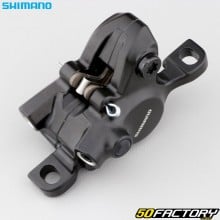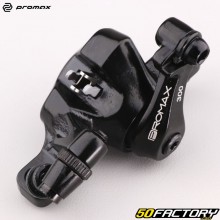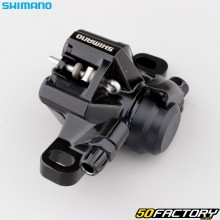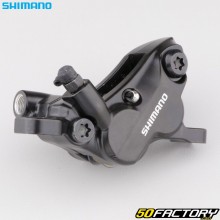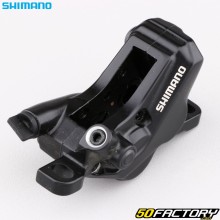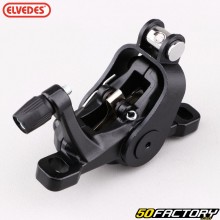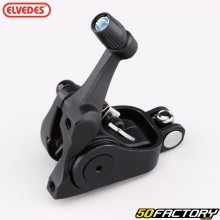 Rear brake caliper
Rear brake caliper
- IN STOCK23€20
- STOCK EXHAUSTED15€70
- IN STOCK33€90
-
- IN STOCK79€10
- IN STOCK57€70
-
- IN STOCK138€40
-
-
- IN STOCK72€10
- IN STOCK77€30
Everything you need to know about the rear brake caliper for VTC trekking
The role of this braking device
The rear brake caliper is a key part of your trekking VTC's braking system. Its role is to squeeze the brake pads against the disc, thus creating the friction necessary to slow down or stop the bike. This device is activated par the brake lever, which transmits the force mechanical or hydraulic to the caliper. Its function is vital, itar Without a working brake caliper, you would not be able to effectively control the speed of your bike, which could lead to dangerous situations.
Importance for bicycle safety
The safety of your bike depends largely on the effectiveness of its braking system. A rear brake caliper in good condition ensures precise and responsive braking, essential for avoiding accidents and navigating with confidence on varied terrain. A faulty device can result in longer braking distances, increasing the risk of incidents. In addition, proper and regular maintenance of this component is crucial to preserve the braking performance of your bike and to ensure a safe and enjoyable ride.
The different types of brake calipers
Depending on your needs and usage, there are two main types of rear brake calipers suitable for VTC trekking. Each has specific characteristics that influence their performance, ease of use and maintenance, but also their cost. It is therefore important to understand how they work to make the most suitable choice for your VTC trekking practice.
Mechanical
Mechanical brake calipers use a cable to transmit the force from the brake lever to the pads. They are generally simpler to install and maintain. However, they may require frequent adjustments to maintain optimum performance. This type is often preferred for its simplicity and affordability. However, they may be less effective on long descents or par humid weather.
Hydraulics
Hydraulic brake calipers, on the other hand, use an incompressible fluid to transmit the force brakes. They offer more precise modulation and superior stopping power. They can be more complex to install and maintain, but they require fewer adjustments once properly set up. This type is ideal for demanding cyclists who are looking for optimum performance. They are particularly suitable for demanding courses and difficult weather conditions.
How to Choose the Right Brake Caliper
Selecting the right rear brake caliper for your trekking bike is a crucial step that directly influences the performance and safety of your mountain bike. It is not just a matter of choosing any model, but of opting for the one that perfectly suits your needs and riding style.
Selection criteria
To choose the right rear brake caliper for your trekking VTC, several criteria must be taken into account:
- Brake type: Mechanical or hydraulic.
- Material : Aluminum for lightness and steel for strength.
- Compatibility: Make sure the caliper is compatible with your brake disc diameter.
- Brand: Choose brands recognized for their reliability and performance.
In addition to these criteria, don't forget to take into account your level of skill in bicycle mechanics. Some models may require more technical installation and maintenance.
Bike Compatibility
Compatibility is a crucial aspect when choosing a rear brake caliper for your trekking bike. Check that the model you choose is compatible with your bike frame, rotor diameter and mounting type (post-mount or IS). Consulting your bike's manual or the manufacturer's website can help you find this information.
Quality and durability
The quality and durability of the brake caliper are also determining factors. A high-quality caliper made with robust materials will guarantee you a long service life and consistent performance. Opt for models that are resistant to corrosion and wear. It is better to invest in a quality product that will last over time rather than having to replace it frequently.
Installation
Installing your new rear brake caliper on your trekking bike is a crucial step to ensure optimal braking performance. Although the procedure may seem complex, a step-by-step process can help youar step will allow you to carry out this operation successfully.
Installation procedure
Here is a step-by-step procedure to guide you through installing your rear brake caliper:
- Remove the rear wheel from your bike.
- Secure the brake caliper to the frame using the appropriate screws.
- Install the brake pads and make sure they are properly aligned with the disc.
- Connect the hydraulic cable or hose to the caliper.
- Reinstall the wheel and check that the disc is centered between the pads.
- Adjust cable tension or bleed hydraulic system if necessary.
Tips for a successful installation
To ensure a successful and smooth installation, here are some additional tips:
- Use the right tools: A set of Allen keys, a screwdriver and a bleeder tool for hydraulic systems are essential.
- Check the manual: Always follow the manufacturer's instructions to avoid mistakes.
- Test the brake: After installation, test the brake on a flat surface before setting out on your ride.
- Take your time : Don't rush the installation. Careful installation is the key to effective braking.
Care instructions
How to maintain your brake caliper
Regular maintenance of your trekking VTC rear brake caliper is essential to ensure optimal performance and extend its lifespan. A well-maintained braking system not only improves safety, but also optimizes driving comfort by providing smoother and more precise braking. Here are some key steps:
- Cleaning : Clean the caliper regularly to remove dirt and debris. Use a clean, dry cloth for this.
- Lubrication: Apply a small amount of lubricant to the pivot points of the mechanical calipers. This will improve their operation and prevent premature wear.
- Purge: For hydraulic systems, flush the brake fluid every 6 months to a year. This helps prevent system contamination and maintain consistent braking performance.
Signs of wear
It is important to monitor for signs of wear to avoid brake problems. It is important to remember that each component of the brake system has a limited lifespan. Here are some signs to watch for:
- Rustles: Squeaking noises may indicate worn pads.
- Loss of power: If you notice a decrease in braking power, it may be time to check the condition of your pads and rotor.
- Liquid leaks: For hydraulic systems, brake fluid leaks are a clear sign of trouble. This can indicate a problem with the caliper seal or a failure of the hydraulic system.
The importance of regular maintenance
Never neglect the maintenance of your rear brake caliper. Regular maintenance can not only extend the life of your brake system, but also allow you to enjoy a safer and more enjoyable ride. Plus, it can help you save money in the long run by avoiding costly repairs due to lack of maintenance.







